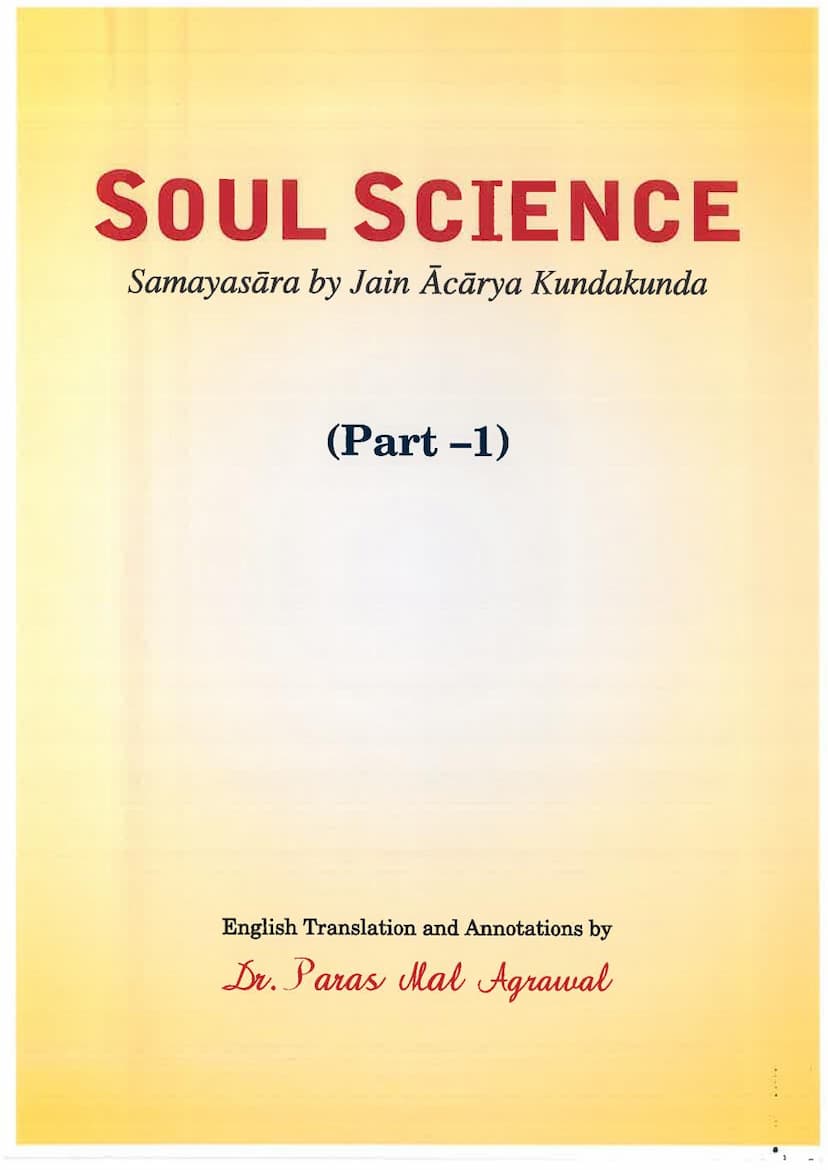Soul Science Part 01
Added to library: September 2, 2025

Summary
Here's a comprehensive summary of "Soul Science Part 01" by Dr. Paras Mal Agrawal, based on the provided text:
Book Title: Soul Science Part 01 Author: Dr. Paras Mal Agrawal Publisher: Kundakunda Jñānapitha Based on: Samayasāra by Jain Ācārya Kundakunda
Core Purpose and Content:
"Soul Science Part 01" is an English translation and annotation of the first 144 stanzas of the ancient Jain scripture, Samayasāra, by Ācārya Kundakunda. The book aims to make the profound teachings of Samayasāra accessible to a modern audience, particularly English readers, by explaining its complex concepts of soul science using contemporary language and scientific examples.
About Ācārya Kundakunda and Samayasāra:
- Significance: Ācārya Kundakunda is highly revered in the Digambara Jain tradition, often mentioned immediately after Lord Mahāvīra and his chief disciple Gautama Ganadhara. Samayasāra is considered his magnum opus and a pinnacle of Jain spiritual literature, offering deep insights into the nature of the soul.
- Literal Meaning: "Samayasāra" translates to "soul in its essence" or "pure soul."
- Content of Samayasāra: The scripture meticulously and logically explores what the soul truly is and what it is not, guiding readers towards realizing their "I-ness" solely with the Samayasāra for ultimate bliss, peace, and happiness.
Dr. Paras Mal Agrawal's Approach and Contribution:
- Author's Background: Dr. Agrawal, a physicist by training, brings a unique blend of scientific rigor and spiritual inclination to his work. His experience as a scientist and visiting professor in the USA has informed his approach, enabling him to bridge the gap between ancient spiritual wisdom and modern scientific understanding.
- Translation and Annotation: The book provides an English translation of the original Prakrit stanzas, followed by detailed annotations. These annotations aim to:
- Explain the meaning of the stanzas in simple, lucid English.
- Clarify complex Jain metaphysical concepts.
- Address potential doubts by raising and answering questions, often using scientific analogies and logical reasoning.
- Incorporate insights from classical commentaries by Ācārya Jayasena and Ācārya Amṛtacandra.
- Highlight the relevance and practical application of the teachings in daily life.
- Modern Relevance: The book emphasizes the need for Jain scriptures in English for the global Jain community and for fostering interfaith understanding in multicultural academic environments. It caters to individuals seeking spiritual solace in a materialistic world.
- Coverage: This first part covers the initial 144 stanzas of the Samayasāra, which form the "Pre-view (Purva Ranga)" and "Soul (Jiva) and non-soul (Ajiva)" chapters.
Key Themes and Concepts Explored (within the first 144 stanzas):
- The Nature of the Soul (Jiva): The book distinguishes the eternal, pure, and conscious soul (Jiva) from non-soul (Ajiva) entities, including physical bodies, emotions, thoughts, and karmic matter.
- Nayas (Points of View): A significant portion of the early stanzas, as presented in the book, focuses on the two main Jain philosophical viewpoints:
- Niścaya Naya (Real Point of View): This perspective emphasizes the true, eternal, and unchanging nature of the soul, separate from all external influences and modifications.
- Vyavahāra Naya (Relative Point of View): This perspective describes the world as it appears, acknowledging the soul's apparent association with the body, karma, and worldly experiences. The book highlights the necessity of understanding both to grasp the full picture, but ultimately points towards the realization of the Self through the Niścaya Naya.
- Dravya and Paryāya: The text distinguishes between eternal substances (Dravya) and their temporary states or modifications (Paryāya), a fundamental concept in Jain metaphysics.
- Karma Theory: The book introduces the doctrine of Karma, explaining how actions (mind, body, speech) lead to the influx and bondage of karmic particles, which in turn influence experiences of pleasure and pain. It clarifies that while these karmic actions are described as the soul's activities from a relative viewpoint, from the ultimate viewpoint, the soul remains untouched and is the knower, not the doer or experiencer, of karma.
- Doership (Kartā): A central theme is the subtle distinction between being the instrumental cause (Nimitta) and the substantial cause (Upādāna) of actions, particularly in relation to karma and external substances. The book argues that from the real point of view, the soul is the doer only of its own pure or impure spiritual states (Bhāva), not of external matter or the karmic forces that influence it.
- Identification and Ownership: The text stresses the importance of realizing the "I-ness" and "my-ness" solely with the soul, distinct from the body, emotions, possessions, and even the karmic influences.
- Purity of the Soul: The soul is described as intrinsically pure, conscious, and eternal, existing independently of any external factors. The perceived impurities are seen as temporary states or associations, not inherent qualities of the soul itself.
- Spiritual Path: The book outlines the path towards self-realization, emphasizing the importance of right belief (Samyag Darśana), right knowledge (Samyag Jñāna), and right conduct (Samyag Caritra) as essential steps, all of which ultimately converge on the singular nature of the soul.
Overall Reception and Value:
The book has received high praise from various experts in Jainology, who commend its clarity, user-friendliness, and the author's ability to integrate scientific examples with profound spiritual philosophy. It is seen as a valuable resource for students of philosophy, individuals seeking spiritual enlightenment, and anyone interested in understanding the essence of Jainism in a contemporary context. The publication is considered a significant contribution to making this vital spiritual text accessible globally.